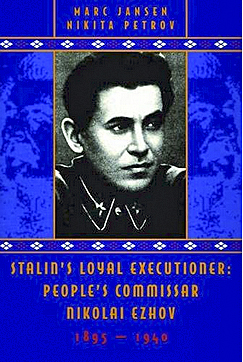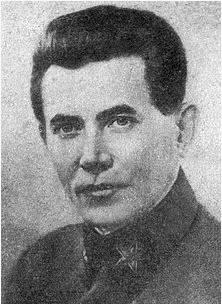
- Articles
Stalin’s Loyal Executioner: People’s Commissar Nikolai Ezhov, 1895-1940 by Marc Jansen and Nikita Petrov
Stalin’s Loyal Executioner: People’s Commissar Nikolai Ezhov, 1895-1940 by Marc Jansen and Nikita Petrov is a great addition to the story of Soviet communism, a story that is still unfolding, but has not completely been told. This book will remain the authoritative source of the life and times of Nikolai Yezhov, until the Russian archives are once again fully opened to scholars. In revealing the life of Nikolai Yezhov, this concise tome also recounts the political times, and more importantly, the moral degeneracy of the Soviet leadership, the communist party, the secret police — the Soviet state itself, rotting from its own evil communist ideology and moral perversion.
The Great Terror of 1937-38 was an outstanding period in the chronicles of the USSR because the vast majority of the victims were not only communists, but Stalinists, who allegedly had not been sufficiently vigilant in finding “enemies of the people” in their midst. In other words, they had not been vigilant communists, and had not informed and found sufficient innocent victims, purportedly potential opponents to Stalin’s supreme authority.
Moreover, Stalin had decided to get rid of the Old Bolsheviks and Chekists, who he no longer “trusted” or stood in the way of his revisionist history of Soviet communism, a history in which only Comrade Stalin stood shoulder to shoulder with the great Lenin.
The story of the police state, political assassinations, arrests in the middle of the night, the use of systematic torture and generalized terror, we must keep in mind, all began with Vladimir Lenin. And we must remember that “permanent revolution” was invented by Leon Trotsky; the use of concentration camps, the implementation of “revolutionary terror,” the extermination of “class enemies,” and the founding of the political police, the legendary, ruthless Cheka, were all instituted by the totalitarian state — not by Stalin or Yezhov — but by the father of the October Revolution, himself, Vladimir I. Lenin. The Red Terror of 1918-1922, in which thousands perished was primarily the work of “Iron Feliks” Dzerzhinsky, Red Army Commissar Leon Trotsky, and the Starik (старик; old man) of Russian communism, Lenin — not Stalin or Yezhov.

By 1936 Stalin needed a younger NKVD chief, who was personally loyal to him and would not hesitate to exterminate what remained of the legendary Old Bolsheviks, such as the “leftist” Trotskyites, Kamenev and Zinoviev; the “party swamp,” Radek, Pyatakov, and “their followers”; and the “rightist bloc,” Bukharin, Rykov, etc, who, in Stalin’s mind still posed a threat to his authority. A younger, loyal, amoral communist comrade, Nikolai Yezhov, was just the man Stalin needed to accomplish such a horrendous task, after the assassination of Leningrad Party chief, Sergey Kirov, in December 1934. For the time being, Yezhov would assist Yagoda in the investigations,interrogations, and the gathering of evidence.
Genrikh Yagoda had been a bloody NKVD chief, but he had not acted fast enough during the Great Purge, according to Stalin, in exposing and exterminating the (concocted) Trotskyite-Zinovievite-Bukharinite conspiracy.
Using torture and threats, Yezhov extracted the needed confessions from the old Bolsheviks, and pleasing Stalin with his results and methods, soon enough, he would displaced Yagoda as chief of the NKVD. Yezhov performed his bloody symphony of terror satisfactorily and completely as required by Stalin, the great conductor. (Later this period in 1950s would be labeled the “Yezhovshchina,” as if to make Yezhov, alone, responsible for the atrocities and “excesses” of the great purges.)
And when the task was completed (which it was in about 18 months), Stalin knew enough about expediency to get rid of the now completely alcoholic, sexually perverted, and morally degenerate Yezhov. And Stalin need not worry; there was always someone available to pick up the pieces and assume the mantle of NKVD chief. The next NKVD chief, Lavrentiy Beria, followed Yezhov; just like Yezhov (1936-1938) had followed in the footsteps of Genrikh Yagoda (1934-1936). As new NKVD chief, Beria rounded up, purged and exterminated all of Yezhov’s appointees and brought his “Georgia Gang” to power — staying in power with his intelligence, cunning, and loyalty, virtually until Stalin’s death in 1953.
Yagoda and Yezhov, and much later Beria, would all end up with a bullet to the back of the skull, the standard treatment for Soviet scapegoats as well as “traitors.”
Yezhov fell from power because he was no longer needed; in fact, he had done an excellent job fulfilling and exceeding the quotas of victims set by Stalin in eliminating “enemies of the people” in all regions of Russia and captive nationalities- from the top of the Soviet hierarchy in the communist party, the security organs (the political police, NKVD), the military, and the regional and district nomemklatura to the lower echelons of Soviet society.
Nikolai Yezhov was not created in a vacuum; he was a product of the evil philosophy of communism in the USSR, forced collectivism under Stalin, just like the “Gang of Four” was a product of Red Chinese communism under the Cultural Revolution of Mao Zedong, or the mass extermination of his own population by Pol Pot in Cambodia. The book is a portrait of evil, only that it encompasses many faces. I recommend this book to all students of Russian Communist history without reservations. The book also has a good index, notes, and rare illustrations.
Written by Dr. Miguel A. Faria
Dr. Miguel A. Faria, Jr. is a former Clinical Professor of Surgery (Neurosurgery, ret.) and Adjunct Professor of Medical History (ret.) Mercer University School of Medicine; Former member Editorial Board of Surgical Neurology (2004-2010); Member Editorial Board of Surgical Neurology International (2011-present); Recipient of the Americanism Medal from the Nathaniel Macon Chapter of the Daughters of the American Revolution (DAR) 1998; Ex member of the Injury Research Grant Review Committee of the Centers for Disease Control and Prevention (CDC) 2002-05; Founder and Editor-in-Chief of the Medical Sentinel (1996-2002); Editor Emeritus, the Association of American Physicians and Surgeons (AAPS); Author, Vandals at the Gates of Medicine (1995), Medical Warrior: Fighting Corporate Socialized Medicine (1997), and Cuba in Revolution: Escape From a Lost Paradise (2002).
This article may be cited as: Faria MA. Stalin’s Loyal Executioner: People’s Commissar Nikolai Ezhov, 1895-1940 by Marc Jansen and Nikita Petrov. HaciendaPublishing.com, December 29, 2011. Available from: https://haciendapublishing.com/stalins-loyal-executioner-peoples-commissar-nikolai-ezhov-1895-1940-by-marc-jansen-and-nikita-petrov/.
An edited version of this review appears on Amazon.com.
Copyright ©2011 Miguel A. Faria, Jr., MD
1 thought on “Stalin’s Loyal Executioner: People’s Commissar Nikolai Ezhov, 1895-1940 by Marc Jansen and Nikita Petrov”
Another executioner was Sergey Spigelglas
Sergey Mikhailovich Spigelglas (1897 – 1941) was acting head of the Soviet foreign intelligence service, then part of the NKVD, from February to June 1938. Spigelglas was born into the family of a Jewish bookkeeper in present-day Hrodna Voblast, Belarus. After graduating from Warsaw Technical High School, he entered the law school at Moscow University, although he did not last long! “In 1917 he was drafted into the Russian Army and served as an ensign in the 42nd reserve regiment. Following the October Revolution, he joined the Cheka, and because of his facility with languages — he spoke French, Polish, German, and Russian — he became a member of the Foreign Department. In 1926, he was stationed in Mongolia, perhaps reporting to Yakov Blumkin, where he conducted active intelligence work against China and Japan. In 1930, Spigelglas became the chief undercover agent of the OGPU, later the NKVD, in Paris. As a cover for his operations, he worked as the bourgeois proprietor of a fish store near the Boulevard Montmartre. Spigelglas’s main task was spying on the White Russian and Trotskyist organizations in Paris, where he controlled the penetration agents Mark Zborowski and Roland Abbiate. He successfully recruited the double agent Nikolai Skoblin and his wife Nadezhda Plevitskaya. Spigelglas returned to Moscow, where he trained new agents in counterintelligence and acted as deputy director of the Foreign Department reporting to Abram Slutsky. His particular forte was the liternoye (top secret) or liquidation operation. He engineered the assassination of the Ukrainian nationalist Yevhen Konovalets in Rotterdam in May 1938, the execution of the defector Ignace Reiss in Switzerland in September 1937, and the kidnapping of the leader of Russian All-Military Union (ROVS), General Evgenii Miller, in France in September 1937. It has also been suggested that he was the mastermind behind the murder-decapitation of the Trotskyist leader of the Fourth International, Rudolf Klement, in France in July 1938, and the murder of the defector Georges Agabekov in France in 1937. When Slutsky died in February 1938, poisoned by order of Nikolai Yezhov, Spigelglas became the acting director of foreign intelligence.
“The head of the NKVD, Lavrenti Beria, had Spigelglas arrested seven months later on November 2, 1938. He was held in Lefortovo prison and attempted a hunger strike which failed once his jailers began a regimen of intravenous feeding. After ‘strong pressure,’ a euphemism for torture, he began to make a confession in May 1939, and a tribunal convicted him of treachery on November 28, 1940. (In his confession, Spigelglas claimed that Lev Sedov died of natural causes, not the victim of NKVD foul play.) He was executed on January 29, 1941. Historical opinion on Spigelglas is divided. Some, following the lead of Alexander Orlov, portray him as a ‘careerist’ ready to liquidate dozens of honest people to advance himself, a man who could disingenuously claim that the deaths of those he murdered were necessary in the Bolshevik’s struggle against their enemies. Others, following Sudoplatov, believe he was polite, business-like, intelligent, and a patriot. The Russian government rehabilitated him in 1991.” https://en.wikipedia.org/wiki/Sergey_Spigelglas